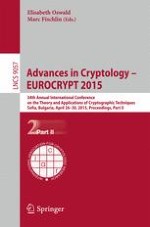The two-volume proceedings LNCS 9056 + 9057 constitutes the proceedings of the 34th Annual International Conference on the Theory and Applications of Cryptographic Techniques, EUROCRYPT 2015, held in Sofia, Bulgaria, in April 2015. The 57 full papers included in these volumes were carefully reviewed and selected from 194 submissions. The papers are organized in topical sections named: honorable mentions, random number generators, number field sieve, algorithmic cryptanalysis, symmetric cryptanalysis, hash functions, evaluation implementation, masking, fully homomorphic encryption, related-key attacks, fully monomorphic encryption, efficient two-party protocols, symmetric cryptanalysis, lattices, signatures, zero-knowledge proofs, leakage-resilient cryptography, garbled circuits, crypto currencies, secret sharing, outsourcing computations, obfuscation and e-voting, multi-party computations, encryption, resistant protocols, key exchange, quantum cryptography, and discrete logarithms.
